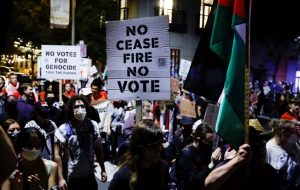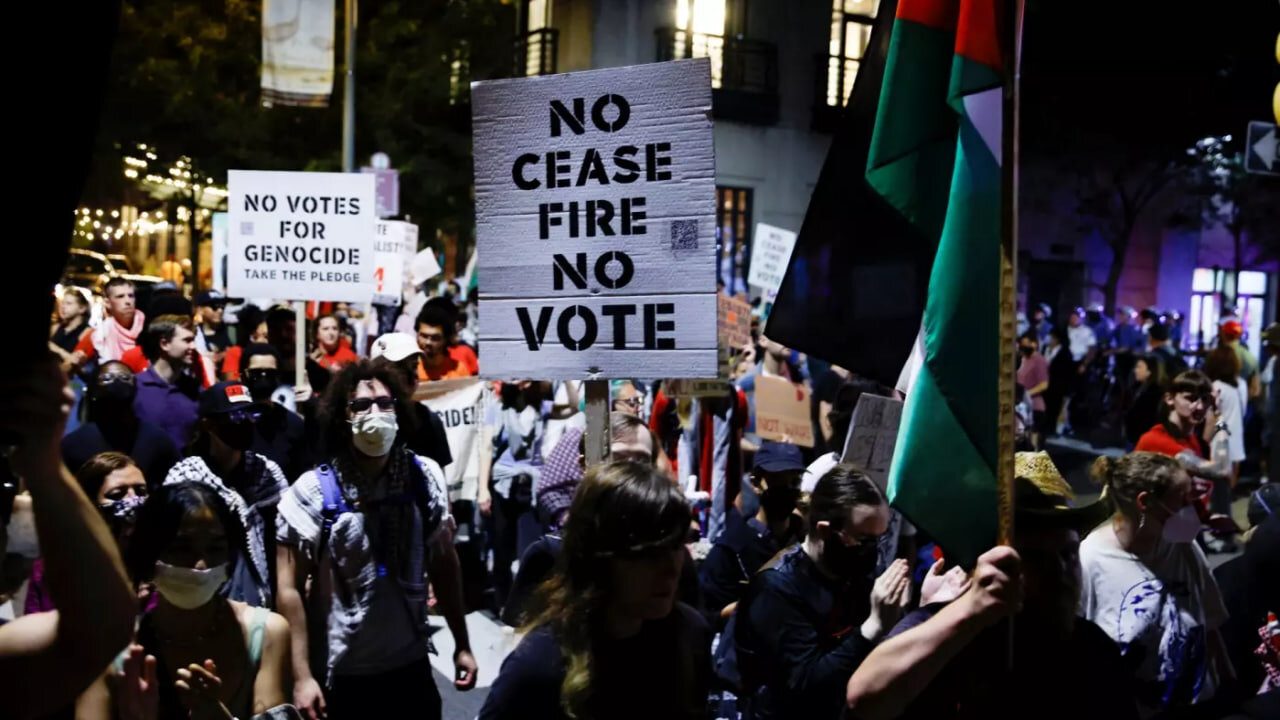Trump did not win this election. Harris was defeated by a Gaza-inspired boycott
When former President Donald Trump snatched victory from the jaws of defeat in the 2016 elections, I wrote an article in Middle East Eye to explain the roots of his mystifying phenomenon. I argued that white racism alone could not explain his victory, and that there were deeper social, economic and political causes behind his rise. Even though the number


When former President Donald Trump snatched victory from the jaws of defeat in the 2016 elections, I wrote an article in Middle East Eye to explain the roots of his mystifying phenomenon.
I argued that white racism alone could not explain his victory, and that there were deeper social, economic and political causes behind his rise.
Even though the number of white voters has been consistently declining in the US – with the most recent US census revealing the number of white Americans had reached a historical low of 62 percent of the general population – they still comprise a majority and represent the bulk of the Republican Party.
But the presence of racism among certain segments of society cannot explain the changes in voting behaviour since former President Barack Obama was elected twice, and four years later, the American electorate had determinedly ousted Trump.
Even though Hillary Clinton beat Trump in 2016 in the popular vote with 66 million votes to 63 million, she still lost the Electoral College vote 306 to 232.
Four years later, Biden had convincingly beat Trump with the same Electoral College ratio of 306 to 232, but then with even a much larger popular vote of 81 million to 74 million, respectively. The main reason was the turnout rate, which improved between the 2016 and 2020 elections from 60 to 66 percent.
So what happened in 2024?
To explain Trump’s 2024 victory after his humiliating defeat in 2020, one would need to examine the voter turnout as well as the vote returns, particularly in the swing states, and conduct a comparative analysis between the 2020 and 2024 elections.
The central issue
In 2020, Biden and Trump garnered together about 155 million voters out of a total of 158 million cast, setting a much higher turnout rate. On the other hand, in the 2024 election, Harris received only 67 million votes, while Trump received less than 73 million.
This clearly shows that Trump has not improved much since he did not even match his 2020 numbers.
Meanwhile, Harris’s votes in 2024 vastly underperformed Biden’s by more than 14 million votes. In the 2024 election cycle, the turnout was about 58 percent, significantly less than in 2020 and even lower than in the 2016 elections.
So what explains the dampening of voter turnout from 155 million in 2020 to 140 million in 2024, even though the number of eligible voters in the US has increased from 240 million to 244 million?
Based on the 2020 election results, the majority of the American people were clearly fed up with Trump. Yet, in 2024, almost 17 percent of Biden’s voters did not show up, and Trump’s support levelled off.
It must also be emphasized that the abuse, contempt, and hostility towards Trump by a significant number of Democratic and independent voters, as well as a minority of Republicans, has remained high or even grown as his unfavourability rating among most voters has increased over the years as many criminal charges have piled up against him.
Looking at the record and policy proposals of each candidate, one would find significant differences in their vision, philosophy, and policies regarding domestic affairs, such as economic policy, budgetary matters, social issues, healthcare, immigration, judicial appointments, political reforms, and so forth.
On the foreign policy and national security fronts, there are also important distinctions and different approaches between both candidates on key issues, including trade, Nato, Ukraine, and China.
But to fully answer this question, one needs to examine the central issue of the election, which both candidates may have agreed on and, at the same time, may have caused a significant number of the electorate to boycott or vote for third parties.
In addition, one needs to scrutinize the swing states’ turnout and voting patterns that usually determine the presidential election winner and loser.
When such an examination is conducted, a similar phenomenon of significant boycott or low turnout emerges.
Voter protest
The one campaign issue where there was remarkable agreement between not only the two major party candidates but also among their respective political parties and operatives has been the unconditional US support for Israel in its ongoing genocidal war on Gaza.
According to several polls, more Democrats sympathize with the Palestinians today than with Israelis. Movements around the country to “Abandon Harris” had also emerged, advocating a vote for third-party candidates like Jill Stein or abstention.
The Republican candidate’s victory over Kamala Harris wasn’t due to his surge in popularity but a conscious choice by millions to boycott the vote over the Democrat-backed genocide
As in the previous two elections, this year’s election hinged on the same six swing states, namely Georgia, Pennsylvania, Michigan, Wisconsin, Arizona and Nevada, which carry a total of 77 Electoral College votes.
Of all the other 44 non-swing states, Harris had 226, while Trump had 235. There were several paths for any combination of swing states that could put either candidate over 270, Harris needing 44 to Trump’s 35.
In the 2020 elections, Biden swept all six swing states, receiving 12.73 million total votes against Trump’s 12.38 million votes in these states for a combined voter turnout of 25.11 million.
On the other hand, in 2024, Trump received 12.55 million votes to sweep the same six swing states while Harris received 12 million, a drop of over 730,000 from Biden’s. In short, the total turnout in the six swing states in 2024 was 24.55 million, reflecting a decline of 560,000 voters from 2020.
While Trump gained a slight increase of 170,000 voters in 2024 in the same six states from his 2020 results, Harris lost 730,000 voters or about 5.7 percent of the 2020 Biden vote, a significant plunge that certainly cost her and her party the elections.
A similar situation took place in the heart of the Arab American communities of Dearborn, Dearborn Heights, and Hamtramck, in the state of Michigan, where the Uncommitted movement was birthed and which reportedly has the largest Arab-American population in the US.
The turnout in these communities in 2024 was also much smaller than in 2020. Biden received 88 percent in the south-end precinct of Dearborn, while Trump got 10.9 percent. In the city of Dearborn, Biden received 69 percent, while Trump received less than 30 percent. In Hamtramck, Biden received 85 percent to Trump’s 13 percent. However, during the 2024 primaries in the midst of the Gaza genocide, Uncommitted’s campaign crushed Biden’s 91 percent to just 4 percent.
Election boycott
Because of the Democratic administration’s backing of Israel’s genocide, this negative trend continued for Harris. According to the Detroit Free Press, Harris received 36 percent in Dearborn, a drop of more than half of the votes Biden received in 2020 and a fourfold increase for Trump at 42 percent.
In Hamtramck, Harris got 38 percent, a decline of 50 points from the Biden vote to Trump’s 44 percent, or a 30-point increase since 2020. Meanwhile, Stein received around a fifth of the vote across the district, possibly the highest she’s gotten across the nation.
It seems that the main reason for Trump’s victory over Harris in 2024 is not a sudden surge in his popularity, as he underperformed his 2020 result in the popular vote in the midst of a devastating pandemic.
Therefore, the most plausible explanation for the low turnout for Harris that cost her the elections compared to Biden in 2020 is a conscious decision by millions, not just Arab and Muslim Americans in the swing states but across the nation, to boycott the vote.
Indeed, millions of other conscientious Americans voicing their principled and strenuous objections to the Israeli genocidal war on Gaza, which was cruelly supported by a morally corrupt political class, also boycotted the elections.
The Harris defeat ought to be an ominous sign to all politicians that Palestinian and Lebanese blood is not cost-free nor expendable.
*Sami Al-Arian is the Director of the Center for Islam and Global Affairs (CIGA) at Istanbul Zaim University. Originally from Palestine, he lived in the US for four decades (1975-2015) where he was a tenured academic, prominent speaker and human rights activist before relocating to Turkey. He is the author of several studies and books. He can be contacted at: nolandsman1948@gmail.com.
